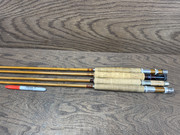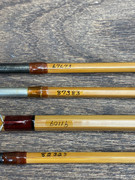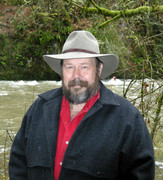


Moderator: Titelines





See the concurrent "Orvis Rod Maker Interview" thread that instigated this discussion:Caneghost wrote: ↑09/14/22 06:49I just acquired a little Madison made in 1981-82 at the Catskill Gathering, and it is lighter cane like the photos above. It looks like an impregnated finish, not the older dark Bakelite brown, but similar in color to a pair of seventies vintage T&T impregnated rods I have...
...I would easily be able to believe that the current marketing department would be out of touch with reality, but not for fifty years. I looked at the pages from the 1981 and 1982 catalogs online, and the rods look just like mine, lighter cane, and the press still talks about seven days in the impregnating tanks with Bakelite resin.
... Could a chemical formula change be at the heart of the light versus dark rods? I could imagine the rod shop foreman making a safety oriented change and not advising the ad men about the technical aspects.
Thanks for this insight....great stuff!wctc1 wrote: ↑09/14/22 17:49Hi Royce: Thanks for your PM. Here's something for the board from my post to you. I check the board several times a week, but haven't had much to say. Like you, I much appreciated the wrapping instructions. Anyway:
Steve Kiley made butts and mid's for Orvis for about 3 years, or a little more. I spent many, many hours working on Orvis blanks except for thread stripping and sanding. I wanted to say I had a hand in making Orvis rods so I pestered Steve for shop time {we lived 3 miles apart}, which he freely granted since his son was growing up. Mainly I ran the mill and the two bevelers, plus helped Steve glue. Steve did the splitting.
I don't remember Steve traveling back to Orvis, but maybe he did. I remember taking care of his cats for about a week once. Quite the forgettable experience since I ended up in the ER with cat allergies. But maybe the trip was to see his mother, just can't remember.
Steve did not impregnate rods for Orvis.. I vaguely remember the reason was Orvis wanted to impregnate at the factory to make sure the butts and mid's matched the tips. I also vaguely remember Steve holding back some honey colored sections so Orvis could match them up with honey tips at their shop.
The reason Steve was dropped from making sections was that he asked for a full year's order so he could plan his work and ordering. When upper management found out that large purchase order was in process, that was it for Steve except for work-in-progress. That's when Orvis fixed their mill.
Anyway Steve experimented a lot and had success in many rod making areas. About the time of the Orvis orders he and Mike Brooks developed a process that turned out a pleasing rod. I think he may have sent a sample back to Orvis for inspection. They talked about patenting the process but didn't because of cost. Someone should contact Mike if he's not still aboard for more info. Steve got a lot of orders for impregnated rods.
Hope this helps. I spent a lot of time in Steve's shop. For example, on one 3 steelhead rod order I kept careful track of my time. I spent 84 hours on those 3 rods. Under Steve's tutelage, I made several rods for myself from splitting through sanding, but since I couldn't wrap well {old broken fingers} I never finished them. Since Steve inspected them along the way, he finished and sold them. Miss Steve.
This is interesting Joe. Makes me wonder if Orvis is using Steve & Mike's process.wctc1 wrote: ↑09/14/22 17:49
...Steve experimented a lot and had success in many rod making areas. About the time of the Orvis orders, he and Mike Brooks developed a process that turned out a pleasing rod. I think he may have sent a sample back to Orvis for inspection. They talked about patenting the process but didn't because of cost. Someone should contact Mike if he's not still aboard for more info. Steve got a lot of orders for impregnated rods.
This gave me clarity. I couldn't understand why it took Orvis 3 years or so years to have the mill rebuilt. They never intended to fix it...wctc1 wrote: ↑09/14/22 17:49...The reason Steve was dropped from making sections was that he asked for a full year's order so he could plan his work and ordering. When upper management found out that large purchase order was in process, that was it for Steve except for work-in-progress. That's when Orvis fixed their mill.
THere's nothing particularly toxic about bakelite. Bakelites are phenol-formaldehyde resins - polymers; and actually the resins used to impregnate wood should not be identified as 'bakelite' as bakelite is a name that should designate a cured resin with filler (like bakelite phones or ashtrays or radios), not just a resin - unfortunately in later years the bakelite company started offering different resins under 'bakelite XXXX' denominations, with XXXX being numbers - the original Wes Jordan patent identifies the impregnation resin as well as the glue used to glue up the splines into blanks by their full product names and numbers.Caneghost wrote: ↑09/14/22 06:49Someone mentioned formaldehyde to me, so I assume it is an ingredient in the Bakelite resins. Do any makers out there know if a less toxic formulation of a "Bakelite resin" exists? Could a chemical formula change be at the heart of the light versus dark rods? I could imagine the rod shop foreman making a safety oriented change and not advising the ad men about the technical aspects.
Thanks for all of that, an excellent explanation.THere's nothing particularly toxic about bakelite. Bakelites are phenol-formaldehyde resins - polymers; and actually the resins used to impregnate wood should not be identified as 'bakelite' as bakelite is a name that should designate a cured resin with filler (like bakelite phones or ashtrays or radios), not just a resin - unfortunately in later years the bakelite company started offering different resins under 'bakelite XXXX' denominations, with XXXX being numbers - the original Wes Jordan patent identifies the impregnation resin as well as the glue used to glue up the splines into blanks by their full product names and numbers.....